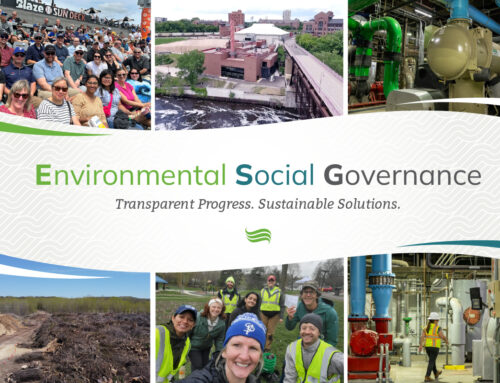
Beneficial Electrification – Smart System Transformation
September 23, 2019 by Ever-Green Energy
This is the first blog in a series on the topic of electrification. In this post, we examine the drivers and keys to success for electrification to achieve climate, efficiency, and economic goals. In the next edition, we will hear from Ken Smith, CEO and President of Ever-Green about how these changes are already taking place in Germany and influencing community and higher education transition in Minnesota.
To ensure shared terminology in this series, review the glossary of frequently-used terms.
As the energy system transforms to become less carbon intensive and more responsive and resilient, electrification is gaining momentum as a strategy to achieve environmental objectives. Electrification is broadly defined as the transition of all sourcing, distribution, and consumption of energy to the electric grid. Proponents of this strategy are promoting a shift of the overall energy system to dependence on the electric grid or energy islands (microgrids) that are self-reliant with their own, isolatable electric infrastructure.
One of the stated purposes of this strategy is to replace natural gas and oil dependencies with more adaptable and renewable resources. It is viewed as one potentially effective approach to largely decarbonize the overall energy system and reduce fossil fuel dependence. Ever-Green Energy also sees a future where the energy system is increasingly electrified. We think it is important to use a holistic approach to this system transformation, which requires any strategic electrification to consider local resources, the efficiency of the entire energy system, and total carbon impact as key indicators of success.
Trends Driving Energy System Change
Renewable electricity nearly doubled between 2008 and 2018. According to the Solar Energy Industry Association, solar electric production in the United States increased 300% from 2014 to 2018. Electric vehicle sales increased by 81% between 2017 and 2018, although electric vehicles make up less than 2% of the market (Source – Inside EVs). Over the past decade, coal has seen the most significant decline, with consumption decreasing by 44% between 2007 and 2018, according to the Energy Information Administration.
Economics are certainly part of the explanation for this exponential growth of renewables and reduction of coal. Costs of solar production are down 73% since 2010 and renewable energy technologies expected to be competitive with fossil fuels by 2020, according to the International Renewable Energy Agency. Deloitte Insights notes three key trends driving renewable deployment: “Rapidly approaching grid parity, cost-effective and reliable grid integration, and technological innovation.”

Three quarters of the top 20 solar and wind states have electricity prices below the US national average.
Subsidies also play a role in the overall economics, but as demand has increased, the market is driving increases in production and reductions in cost from manufacturing to installation. It is also important to acknowledge that subsidies exist across the entire energy sector and will continue to be a factor as the system changes. The increased availability and reduced costs of natural gas in the U.S. have also influenced the retirement of coal, sparking debates over the future of natural gas as the default fuel in systems or as a bridge to the integration of more renewable fuel sources.
Amidst the upward trends in technology and economics, concerns over climate change and the environmental impacts of fossil fuels are also driving change in priorities. Many major investor-owned utilities, cities, states, and higher education institutions are signing on to voluntary clean energy and decarbonization goals. It is important to note that many of the commitments to 100% renewable energy made by companies and utilities in recent years are commitments to renewable electricity, often accomplished through renewable purchasing programs, which promotes development of these solutions. Others have looked at carbon as the primary driver for their goals, which would include all energy uses. Many of Ever-Green’s partners have set goals for 100% carbon-free energy portfolios, including the campuses participating in our Roadmap to Carbon Neutrality program and Oberlin College.

The Adam Joseph Lewis Center was designed with all things green in mind—from waste water recycling to solar panels.
Photo credit: Tanya Rosen-Jones ’97
The Push for Electrification
When considering these shifts in market demand and the potential dominance of renewables on the electric grid by 2050, it is understandable that electrification is emerging as a key strategy to decarbonize the energy system. Proponents see a decarbonized electric grid and electrified end uses as a better strategy for sectors that are more fossil fuel dependent, including the transportation, industrial, residential, and commercial sectors. These sectors make up 62% of our nation’s energy, which still need a better solution for decarbonizing.

Total US Greenhouse Gas Emissions by Economic Sector in 2017
The energy consumed in those sectors is predominantly industrial process loads (example: manufacturing) and the heating and cooling of buildings. In parts of the country without natural gas infrastructure, a small portion of this combined sector is already electrified. But for the most part, these end uses are served by combustion of natural gas or delivered fuels, such as propane or fuel oil. With decarbonization progress being made through improvements to the environmental profile of the electric grid and related electrification of vehicles, attention is now shifting to electrifying these remaining sectors.
This trend is emerging in local policy, such as the City of Berkeley’s recent decision to eliminate the natural gas option from new building construction. Electrification has also been considered in new site development, as planners consider how to design for net zero carbon sites. These plans emphasize energy efficiency as the baseline and often count on the mix of renewables already on the regional grid or depend on fossil fuel supplies for redundancy or backup. The intent is to move toward a system that is more independent from fossil fuels, but for a phased approach that considers reliability and cost as essential.
What are the Hurdles to Electrification?
Moving these sectors to all-electric dependency is currently limited by available technology solutions and associated costs for transition and operating these functions on electricity alone. This includes the following constraints:
- The cost to heat a building with electricity in Northern climates
- The potential need to backup an electrified solution with traditional heating, ventilation and air conditioning (HVAC) equipment, doubling costs for heating that building.
- The capacity limitations of the grid to take on this additional load on a large scale.
- The current cost and integration limitations of battery storage, which are expected to change significantly in the next decade.

The 2018 energy flow chart released by Lawrence Livermore National Laboratory details the sources of energy production, how Americans are using energy, and how much waste exists.
The overall efficiency of this approach, given that the U.S. electric grid was 38.2% efficient in 2017, according to the Lawrence Livermore National Laboratory. Newer models of boilers and furnaces are above 90% efficient in converting fuel to heat. Efficiencies can be even greater when incorporating district energy to improve operating efficiencies and incorporate stranded thermal energy sources, such as combined heat and power and geothermal. This means a shift to electrification without consideration of overall energy productivity could actually result in an increase of carbon and reduced effectiveness of renewable integration.
So if this transition poses challenges to the grid, reliability, and ratepayers, what is the alternative?
A Shift in Approach: Beneficial or Strategic Electrification
[perfectpullquote align=”right” bordertop=”false” cite=”” link=”” color=”” class=”” size=””]Beneficial electrification accounts for the importance of using all available resources, considering overall efficiency, and keeping carbon as a key indicator of success when shifting energy sources and solutions.[/perfectpullquote]
Beneficial electrification accounts for the importance of using all available resources, considering overall efficiency, and keeping carbon as a key indicator of success when shifting energy sources and solutions. Ever-Green supports beneficial electrification because of the focus on carbon reduction, emphasis on efficiency, and integration of all locally available resources. The Environment and Energy Study Institute defines beneficial electrification as the replacement of “direct fossil fuel use with electricity in a way that reduces overall emissions and energy costs” to the benefit of the end-user and the environment.
From a planning perspective, this requires an approach that looks at overall outcomes, not just initial inputs. The baseline is often the same; looking at reducing the energy demand of buildings, increasing the use of renewable energy options, and considering how electricity can replace or supplement existing fossil fuel or combustion technologies to provide heating, cooling, or industrial process demands.
For example: Transportation makes up almost 29% of our energy demand in this country, as electric vehicles currently make up only 2% of that sector. As a country, electrification of all vehicles, in the absence of storage solutions, would require significant investments and expansion of the electric grid.
This does not mean this goal is out of reach, but that we must look at how changes to one sector impact the others.
In technical application, this will vary from project to project. For example:
Net-zero site development with district energy and aquifer thermal energy storage:
For a recent energy master plan, Ever-Green developed a multi-phase approach that used a low-temperature district energy system to distribute energy between residential and commercial buildings and an aquifer thermal energy system (ATES). ATES systems utilize the low flow nature of an aquifer as a storage system for hot or chilled water, rejecting heat into it during the summer and extracting heat from it in the winter. In the summer, heat is extracted from buildings, and it is stored in the aquifer on one side of the site. Conversely, in the winter, heat is extracted from that aquifer water to heat buildings, and the cooled water is stored on another side of the site. Each building on the system will extract or input heat into the core water loop through heat pumps or heat recovery chillers.

Aquifer Thermal Energy Storage – Heating in Winter and Cooling in Summer
This approach shifts the thermal load from dependency on fossil fuels to a combined strategy of renewable and carbon-free thermal resources and use of electric-dependent HVAC equipment, such as heat pumps. The result is a reduction in the overall carbon intensity of the energy profile and lessening of the burden on the electric grid. It also encourages the reuse of an otherwise wasted resource and promotes a localized solution.
Determining solutions or timing of fuel supply is going to vary by project, region, and sector. In Ever-Green’s master planning work, we are intentional about evaluating these types of questions and related solutions on a case by case basis, using discoveries from other projects. It has worked best to use resources that are local and readily available to a given system. This may mean slightly more work on the front end to customize projects for a local campus or community, but will gain significant efficiencies and benefits over the project’s life cycle.
Case Studies — Mission Rock, Rice Creek Commons, & Towerside
In addition to shifting the policy structures, we also must help the market understand what is possible through innovation and holistic, system-level planning. Ever-Green is currently developing several beneficial electrification projects in the U.S., with each leveraging the availability of a local thermal energy source to provide baseline thermal energy to work with electric.
MISSION ROCK
Mission Rock is a sustainable development in San Francisco, which is a partnership between the San Francisco Giants, Tishman Speyer, and the San Francisco Port. The 28-acre project will be served by a district energy system that will leverage energy available from the San Francisco Bay. Using this energy exchange solution would eliminate the combustion of natural gas at Mission Rock, reducing carbon emissions by nearly 2,400 tons per year upon full site development, the equivalent of removing 1,781 cars per year.
RICE CREEK COMMONS
Rice Creek Commons is a 427-acre site in Arden Hills, Minnesota, that is slated for major residential and commercial redevelopment. Ever-Green has been working with Ramsey County and the developers to develop a multi-faceted approach to energy infrastructure for the site that includes the potential for a low-temperature district energy system utilizing the locally treated groundwater remediation loop. This loop possesses enough energy to meet all of the thermal needs of the planned Rice Creek Commons residential neighborhoods. Implementation of all recommended opportunities can reduce greenhouse gas emissions by as much as 70% from business-as-usual design and energy delivery, potentially reaching net-zero status in some areas of the site.
TOWERSIDE
Towerside is a 370-acre site that stretches between Minneapolis and Saint Paul on the eastern edge of the University of Minnesota that has been developed through a partnership with local community leaders in the public and private sectors. Through a partnership with Ever-Green, this project is pursuing the potential of an aquifer thermal energy storage source for a low-temperature district energy system. This would use a form of geothermal exchange for heating and cooling, paired with heat pumps and heat recovery chillers in individual buildings and would have the potential to lower the carbon profile and water consumption for all connected buildings.
Partners Pursuing Systemic Improvements
There are already several policy and market initiatives underway to support this shift in perspective. The Great Plains Institute will be exploring the decarbonization of the natural gas system in the next phase of its E21 initiative.
The Midwest Renewable Energy Tracking System has recently launched a pilot project to allow companies to claim environmental credits for using renewable natural gas or gas alternatives.
There are currently 14 states with renewable portfolio standards that include renewable thermal, as discussed in the Renewable Thermal in State Renewable Portfolio Standards report by the Clean Energy States Alliance.
Lastly, the State of Minnesota has been undergoing an examination of fuel-switching that could be supported under the State’s Conservation Improvement Program (CIP). A shift in this approach would allow for technologies that currently lack subsidies to better compete against more established solutions, if they can help achieve the goals of CIP to reduce gas and electric usage and increase environmental benefits to the state. For example, geothermal and solar thermal are classified as energy efficiency instead of renewables and are often left out of the menu of solutions with other renewable technologies. There is potential that changes in the state framework could allow these solutions a better chance for integration when focused on outcomes.
Conclusion
As the energy system evolves, it is critical to consider an approach that integrates all available resources and keeps costs within reach for energy users. Beneficial electrification is an effective strategy for bringing together the best available technologies with the most practical solutions in the marketplace. Energy planners and decision makers have a responsibility to consider the benefits of incorporating these thermal resources to balance the growing demands on the electric grid and the expansion of the electrification trend. A more comprehensive approach will be the key to bringing together a system transformation that is dynamic, cost-effective, reliable, and significantly reduces the carbon profile of energy consumption in the U.S.
| What is electrification? |
| The transition of all sourcing, distribution, and consumption of energy to the electric grid in an effort to reduce carbon and fossil fuel consumption. |
| What is beneficial electrification? |
| The replacement of “direct fossil fuel use with electricity in a way that reduces overall emissions and energy costs” to the benefit of the end-user and the environment (source: The Environment and Energy Study Institute). |
| Why beneficial electrification? |
| This more holistic approach to transformation of the energy system looks to incorporate low-grade thermal resources to reduce stress on the electric grid; for example, waste heat recovery, geo-exchange, etc.; improve economics of systems undergoing transition and costs for end-users; and achieve greater carbon reductions. |
| What is energy productivity? |
| A measure of the economic benefit of each unit of energy consumed. The formula is total economic output (GDP or revenue) by amount of energy consumed (source: Alliance to Save Energy) |




